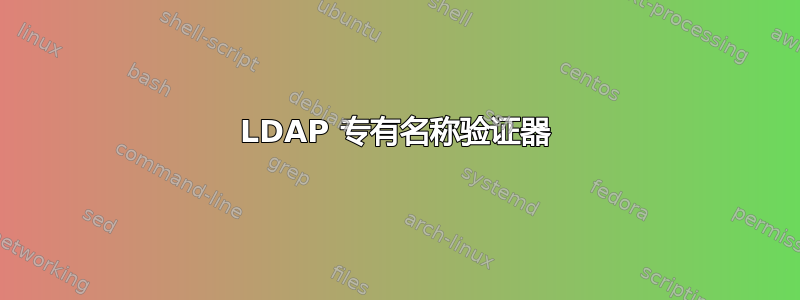
是否有一个库、程序或简单的正则表达式来检查输入中指定的 DN 是否格式正确?
例如:输入:manager,ou=company,dc=net ---> 输出:格式不正确
输入:cn=manager,ou=company,dc=net ---> 输出:格式正确
答案1
在 perl 中,Net::LDAP这几乎是微不足道的:
#!/usr/bin/perl
use strict;
use warnings;
use Net::LDAP::Util qw/canonical_dn/;
foreach my $dn (@ARGV) {
if (!defined(canonical_dn($dn))) { print "not well formed: $dn\n"; }
else { print "well formed: $dn\n"; }
}
然后:
$ perl ldapdn.pl "manager, ou=company, dc=net" "cn=manager, ou=company, dc=net"
not well formed: manager, ou=company, dc=net
well formed: cn=manager, ou=company, dc=net
有许多函数可以验证 DN,ldap_explode_dn()如果您希望规范化和进一步处理 DN,这些函数也可能有用。
值得注意的是,“格式良好”和“有效”并不是一回事,因为语法上格式良好的 DN 可能与特定 LDAP DIT 的模式不匹配,因此被拒绝。
如果你有 OpenLDAP,任何较新的版本都应该附带一个slapdn程序。这做正确的模式检查,但您必须slapd.conf在运行它的系统上设置可行的模式(由于操作配置文件的文件权限,可能需要以 root 或特殊用户身份运行它)。
$ /usr/local/sbin/slapdn -v "cn=manager, ou=company, dc=net"
DN: <cn=manager, ou=company, dc=net> check succeeded
normalized: <cn=manager,ou=company,dc=net>
pretty: <cn=manager,ou=company,dc=net>
(如果您从源代码构建了 OpenLDAP,它还会附带一个dntest作为其测试套件的一部分构建的程序。它仅解析 DN,不检查模式。遗憾的是它没有可用的错误代码,并且似乎偶尔会用段错误指示格式错误的 DN……)
最后,正则表达式方法。正如@voretaq7所建议的,你可以使用澳大利亚国家橄榄球联盟从RFC 4514,不过你还需要RFC 4512(§1.4)。通过任何 ABNF 到 ERE 转换器运行它们(例如abnf2regex,用 Java 实现),然后它就弹出来了。我不会在这里粘贴它,它大约有 4k 的线路噪音。abnf2regex不过,你可以用以下方法破解整个难题:
$ java -jar abnf2regex.jar -t distinguishedName \
"cn=manager,ou=company,dc=net" rfc4512.abnf rfc4514dn.abnf
Rule "distinguishedName" matches: cn=manager,ou=company,dc=net
Rule: [relativeDistinguishedName *(COMMA relativeDistinguishedName)]
Expanded: [(((%x41-5a / %x61-7a) *(%x41-5a / %x61-7a / %x30 / %x31-39 / %x2d))
... <<expanded ABNF snipped>>
Regex: (?:(?:[A-Za-z][\-01-9A-Za-z]*|(?:[01-9]|[1-9][01-9]+)(?:\.(?:[01-9]
... <<expanded regex snipped>>
以上代码是针对特定命名规则 ( -t distinguishedName) 生成的正则表达式测试字符串。如果你眼尖的话,你会注意到我做了一点小手脚,我从 DN 中删除了空格,因为它从技术上来说,不属于 DN并会中断比赛。
最后(这次是真的)简化且不完善 正则表达式你可以使用pcregrep -i:
^([a-z][a-z0-9-]*)=(?![ #])(((?![\\="+,;<>]).)|(\\[ \\#="+,;<>])|(\\[a-f0-9][a-f0-9]))*
(,([a-z][a-z0-9-]*)=(?![ #])(((?![\\="+,;<>]).)|(\\[ \\#="+,;<>])|(\\[a-f0-9][a-f0-9]))*)*$
我已经将它填充并包裹起来,以便可以清晰地阅读,或者说,可能不那么难以辨认。简化的分解如下
^(attributename)=(attributevalue)(,(attributename)=(attributevalue))*$
和
attributevalue = not leading space or octothorpe |
any char except specials |
escaped specials |
escaped hex-digit pair
这需要至少以下自由:
- 它在很大程度上忽略了 Unicode(尽管你可能会发现
pcregrep --utf有帮助),并且不会验证 UTF-8 - 它不支持属性类型中的直接数字 OID
- 它不支持多值 RDN(例如
cn=Bob+sn=Smith) - 它不处理未转义的尾随空格
按照规范,它不处理“,”开头、结尾或周围的不必要的格式化空格。
答案2
别担心。您正在与之通信的 LDAP 服务器已经知道无效 DN 是什么样子。只需捕获错误(响应代码)并采取适当措施即可。
答案3
openldap 库提供了这个子程序,我不知道 ruby、perl 等的任何 ldap 接口是否提供对此 api 的访问。但我没有仔细查看。
ldap_str2dn() parses a string representation of a distinguished name
contained in str into its components, which are stored in dn as
ldap_ava structures, arranged in LDAPAVA, LDAPRDN, and LDAPDN terms,
defined as:
typedef struct ldap_ava {
char *la_attr;
struct berval *la_value;
unsigned la_flags;
} LDAPAVA;
答案4
我改进了我的问题,添加了我的简单(可能太简单了)替代答案:我创建了一个正则表达式来匹配所有可能的 DNS
(\w+[=]{1}[a-zA-Z0-9\-\$&\(\)\[\]\{\}\.\s]+)([,{1}]\w+[=]{1}[a-zA-Z0-9\-\(\)\[\]\{\}\.\s]+)*


